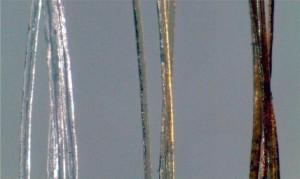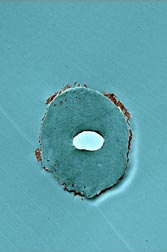Providentially, the Aug. 21, 2012 (I often get the notices a day later) news release on EurekAlert announced a special symposium on controversial science being held at the Fall 2012 meeting,
The news releases lists a number of presentations included as part of the symposium,
Abstracts
Every Day in Every Way, Chemistry Makes the World Ever Better
Richard N. Zare, Marguerite Blake Wilbur Professor in Natural Science, Stanford University
Such were not the titles or contents of Rudy Baum’s editorials in Chemical & Engineering News, although many of my friends had wished otherwise. Instead, Rudy followed a far riskier path of provoking thought and broaching controversial topics. Whether you agreed or disagreed with his points of view, they raised the level of discourse about the role of chemistry in society. Let me congratulate Rudy Baum on his many years of editorship of the flagship weekly of the American Chemical Society. He always made it clear to his readers that he was speaking for himself, not the Society, and I applaud his boldness and daring. The turtle only advances by sticking its neck out.
It’s Not Just About the Science
Eugenie Scott, Executive Director, The National Center for Science Education (NCSE)
The National Center for Science Education defends the teaching of evolution and climate change, two topics on which there is considerable scientific consensus but strong ideological pushback from the general public. How does one change the perception of the public to more closely parallel that of scientists? The normal reaction of scientists is to bemoan the quality of science education, and propose that more and better science instruction will solve the problem. However, multifactorial problems require multifactorial solutions, and the rejection by substantial proportion of the public of well-established science is certainly multifactorial. We need to go beyond science (and science education) to consider the underlying ideological sources of the rejection and how best to deal with them.
Where in the World Will Our Energy Come From?
Nate Lewis, George L. Argyros Professor of Chemistry, California Institute of Technology
Where in the world will our energy come from? What would it take for the world to get away from fossil fuels and switch over to renewable energy? It takes more than willingness to buy a Prius or to have solar panels installed on your roof. If we want to use wind, solar thermal, solar electric, biomass, hydroelectric and geothermal energy it will take a lot of planning, and willingness on the part of governments and industry. It takes R&D investment, a favorable price per unit of energy to get anyone to produce alternative energy, and plenty of resources to create those energy sources.
Lewis will discuss these and other hurdles – technical, political, and economic – that must be overcome before the widespread adoption of renewable energy technologies.
Odds Are It’s Wrong: How Misuse of Statistics Fuels Scientific Controversy
Tom Siegfried, Editor-in-Chief, Science News
Standard tests of statistical significance are widely recognized to be deeply flawed, but are nevertheless widely used in scientific studies. Far from merely a technical concern, this issue is literally a matter of life and death. Misuse of statistics generates controversies about the safety of medicines such as antidepressants that end up depriving some people of life-saving treatments. Media coverage of such issues — and scientific results in general — is confounded by the diabolical coincidence that the qualities of a scientific finding that make it newsworthy are also the qualities that render it most susceptible to being a statistical illusion.
Beware! Breaking a Paradigm can Result in Pain and Suffering
Chris Enke, Professor of Chemistry (Retired), University of New Mexico
Innovators who overturn established paradigms frequently encounter antipathy (or worse) from their scientific communities. I believe a principal cause of this reaction is confusion over which parts of scientific knowledge are facts and which are theories subject to change. We rely on verified observations and established relationships to be true and repeatable within given boundaries. However, the explanations we conceive for these relationships, even though experimentally and theoretically supported to various degrees, are neither proven nor unique. Strong attachments to widely accepted explanations influence our responses to messengers bringing news of their demise.
Toxics, Carcinogens & Mutagens …..Oh My!
Glenn Ruskin, Director, Office of Public Affairs, American Chemical Society
Generally, people fear the unknown. The general public and media often struggle with highly complex scientific issues and topics, especially those with strange names, scary properties and controversy attached to them. When confronted with the unknown, most people will “take flight” – preferring to avoid the topic or issue. In many cases, people will look to experts or organizations they think they “trust” to help explain the issue to them. People want complex and controversial topics broken down into the simplest of terms so they can make informed decisions. Unless scientists or the presenters of complex and controversial science can effectively communicate with the media and general public – disastrous outcomes can result. This presentation will look at how scientific topics can effectively be presented to foster public understanding.
Why I Love A Good Poison
Deborah Blum, Helen Firstbrook Franklin Professor of Journalism, University of Wisconsin-Madison
Journalists, they say, are drawn to controversy. Or in my case, controversial – and often hazardous – chemical compounds. Some of this has to do with the way story-telling works – a writer needs theatre to make a story compelling. But in the case of science writers, like myself, we are usually looking for the “teachable moment” that goes with that controversy, that hazard, that highly readable tale. We can use such cases to delve into everything from peer review to the realities of observational studies. And a chemistry blogger like myself can use a good poison to illustrate much about how the science works – and whether it works well.
Reporting Ethical Violations In Research
William G. Schulz, News Editor, Chemical & Engineering News
A reporter’s notebook of stories that have covered a wide range of ethical violations, including one of the worst cases of scientific fraud ever. Research ethics stories often challenge journalists to hew to their own code of ethics and avoid the pitfalls that might threaten their own journalistic reputations.
The Hockey Stick and the Climate Wars: Dispatches From The Front Lines
Michael E. Mann, Director, Earth System Science Center, The Pennsylvania State University
A central figure in the controversy over human-caused climate change has been “The Hockey Stick,” a simple, easy-to-understand graph my colleagues and I constructed to depict changes in Earth’s temperature back to 1000 AD. The graph was featured in the high-profile “Summary for Policy Makers” of the 2001 report of the Intergovernmental Panel on Climate Change (IPCC), and it quickly became an icon in the debate over human-caused (“anthropogenic”) climate change. I will tell the story behind the Hockey Stick, using it as a vehicle for exploring broader issues regarding the role of skepticism in science, the uneasy relationship between science and politics, and the dangers that arise when special economic interests and those who do their bidding attempt to skew the discourse over policy-relevant areas of science. In short, I attempt to use the Hockey Stick to cut through the fog of disinformation that has been generated by the campaign to deny the reality of climate change. It is my intent, in so doing, to reveal the very real threat to our future that lies behind it.
Covering Controversial Science for C&EN
Rudy Baum, Editor-in-Chief, Chemical & Engineering News
Science is a system for understanding nature, the only system that yields testable knowledge. Since its inception, some of the knowledge uncovered by science has been controversial because it clashed with the revealed “truth” of religious beliefs. The most prominent such clash has been the controversy over Darwinian evolution that continues today. More recently, science has been controversial when it threatened economic interests as was the case with research that established a link between smoking and cancer, CFCs and stratospheric ozone depletion, and human activities and climate disruption. I have been reporting and commenting on controversial science throughout my 32-year career at C&EN and will draw from those experiences in my talk.
Other Talks in the Symposium
Is it ‘News’ if It Happens Slowly?
George M. Whitesides, Woodford L. and Ann A. Flowers University Professor, Harvard University
Communicating Science that People May Not Be Ready to Hear
Paul T. Anastas, Director, Center for Green Chemistry and Green Engineering, Teresa and H. John Heinz III Professor in the Practice of Chemistry for the Environment, School of Forestry & Environmental Studies, Yale University
Thanks for Writing
Bassam Z. Shakhashiri, President, American Chemical Society, Professor of Chemistry, University of Wisconsin-Madison
I wish I could have been there, this looks like a very interesting lineup. Perhaps some of our Canadian science conference organizers can take some inspiration from this symposium for future meetings here in Canada.
By the way, I notice that George Whitesides is listed (third from the bottom) as one of the symposium presenters. Whitesides was last featured here in a posting titled, Watch out Roomba! Camouflaging soft robots are on the move (Aug. 17, 2012).

